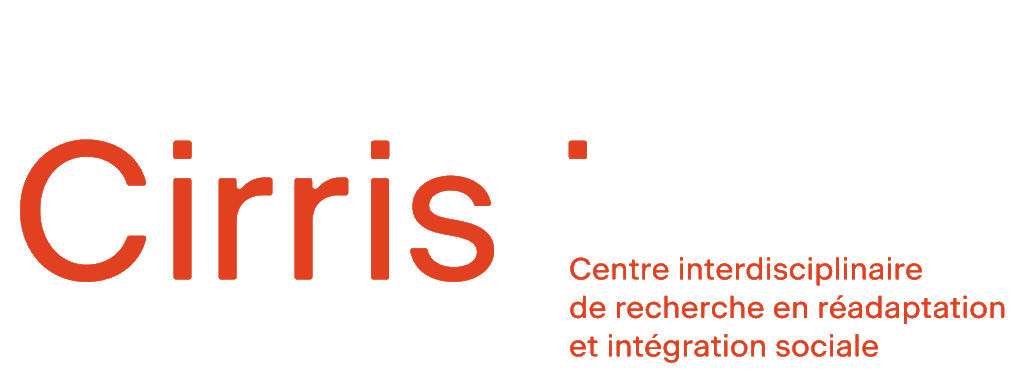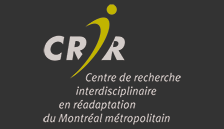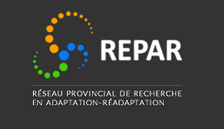You will find below sources and bibliographical references related to the “Participatory Research FAQ” video clips
Participatory research
#2 What issues can be addressed by a participatory research project?
Case studies :
Museums
Video presentation of the research project (in french) and project sheet – Link
Training
National Table created at the end of the research project “Thinking and acting together in training and awareness. Initiative for an inclusive society for people with functional limitations “.
Rochette A, Roberge-Dao J, Roche L Kehayia E, Ménard L, Robin JP, Sauvé M, Shikako-Thomas K, St-Onge M, Swaine B, Thomas A, Vallée-Dumas C & Fougeyrollas P. Advancing inclusion through societal awareness and training activities: an intersectoral and integrated knowledge translation approach with community stakeholders. BMC Research Involvement and Engagement (submitted on 2020-06-15)
Public Transit
Article
Published in the December issue of the Canadian Journal of Disability Studies (in french)
Case Study
Inclusive Mobility – Successful pilot projects and a new STM service offer: a customized learning program for clients with functional limitations
Partnership
#5 How to establish and decide roles and responsibilities of each member of the partnership?
Hoekstra, F., Schaefer, L., Athanasopoulos, P., SCI Guiding Principles Consensus Panel., & Gainforth, H. L. (2021). Researchers’ and Research Users’ Experiences With and Reasons for Working Together in Spinal Cord Injury Research Partnerships: A Qualitative Study. International Journal of Health Policy and Management.
This qualitative study provides a new understanding of spinal cord injury researchers’ and research users’ partnership experiences over time.
#6 How to identify the right research user when wanting to establish a partnership?
Hoekstra, F., Mrklas, K. J., Khan, M. McKay, R. C., Vis-Dunbar, M., Sibley, K. M., Nguyen, T., Graham, I. D., SCI Guiding Principles Consensus Panel., & Gainforth, H. L. (2020) A review of reviews on principles, strategies, outcomes and impacts of research partnerships approaches: a first step in synthesising the research partnership literature. Health Research Policy and Systems, 18,51.
This review of reviews presents overarching principles, strategies, outcomes, and impacts of research partnerships. The findings are synthesized from partnership literature across different research areas involving different groups of research users.
#7 How can you establish a research partnership that is meaningful, avoids tokenism, and focuses on shared decision making?
The paper presents the IKT Guiding Principles for conducting and disseminating spinal cord injury research in partnership. This paper describes the process of rigorously and systematically co-developing the IKT Guiding Principles.
Gainforth, H. L., Hoekstra, F., McKay, R., McBride, C. B., Sweet, S. N., Martin Ginis, K. A., Anderson, K., Chernesky, J., Clarke, T., Forwell, S., Maffin, J., McPhail, L. T., Mortenson, W. B., Scarrow, G., Schaefer, L., Sibley, K. M., Athanasopoulos, P., & Willms, R. (2020). Integrated Knowledge Translation Guiding Principles for Conducting and Disseminating Spinal Cord Injury Research in Partnership. Archives of physical medicine and rehabilitation, S0003-9993(20)31155-2. Advance online publication.
#8 How can I check if the partnership is meaningful and collaborative?
The integrated knowledge translation (IKT) guiding principles were developed to support IKT partnerships to conduct quality and ethical research in spinal cord injury (SCI) that is relevant, useful, useable, and avoids tokenism.
Communication of results and follow-up
#13 How can we retain knowledge through the transfer of skills and data ?
Diagram and content from:
Graham, I. D., Logan, J., Harrison, M. B., Straus, S. E., Tetroe, J., Caswell, W., & Robinson, N. (2006). Lost in knowledge translation: time for a map?. The Journal of continuing education in the health professions, 26(1), 13–24.
Case study:
Hammouni, Z., Poldma, T., Kehayia, E., Verduyckt, I., Martiniello, N., Hervieux, E., & Wittich, W. (2021, July). Designing an Inclusive Theatre Environment: Co-creating a Relaxed Performance Within the Segal Centre for Performing Arts in Montreal. In International Conference on Applied Human Factors and Ergonomics (pp. 233-238). Springer, Cham.”
#14 Once a project is completed, how can the results be communicated to promote it?
For the step “adapting knowledge to the local context”:
Harrison, M. B., Graham, I. D., Fervers, B., & van den Hoek, J. (2009). Adapting knowledge to a local context. Knowledge translation in health care: Moving from evidence to practice, 73, 82.
Fervers, B., Burgers, J. S., Voellinger, R., Brouwers, M., Browman, G. P., Graham, I. D., … & ADAPTE Collaboration. (2011). Guideline adaptation: an approach to enhance efficiency in guideline development and improve utilisation. BMJ quality & safety, 20(3), 228-236.
Canada, H. (2018, November 23). Knowledge Translation Planner [Education and awareness] Online.
Straus, S. E., Tetroe, J., & Graham, I. D. (2013). Introduction knowledge translation: what it is and what it isn’t. Knowledge translation in health care, 1-13.
For the step “assessing facilitators and barriers”:
Salbach, N. M., Jaglal, S. B., Korner-Bitensky, N., Rappolt, S., & Davis, D. (2007). Practitioner and organizational barriers to evidence-based practice of physical therapists for people with stroke. Physical therapy, 87(10), 1284-1303.
Nilsen, P. (2020). Making sense of implementation theories, models, and frameworks. In Implementation Science 3.0 (pp. 53-79). Springer, Cham.
Michie, S., Johnston, M., Abraham, C., Lawton, R., Parker, D., & Walker, A. (2005). Making psychological theory useful for implementing evidence based practice: a consensus approach. BMJ Quality & Safety, 14(1), 26-33.
Cane, J., O’Connor, D., & Michie, S. (2012). Validation of the theoretical domains framework for use in behaviour change and implementation research. Implementation science, 7(1), 1-17.
Mosavianpour, M., Sarmast, H. H., Kissoon, N., & Collet, J. P. (2016). Theoretical domains framework to assess barriers to change for planning health care quality interventions: a systematic literature review. Journal of multidisciplinary healthcare, 9, 303.
For the step “selecting, tailoring and implementing interventions”:
Canada, H. (2018. Knowledge Translation Planner [Education and awareness] Online.
Michie, S., Johnston, M., Francis, J., Hardeman, W., & Eccles, M. (2008). From theory to intervention: mapping theoretically derived behavioural determinants to behaviour change techniques. Applied psychology, 57(4), 660-680.
Little, E. A., Presseau, J., & Eccles, M. P. (2015). Understanding effects in reviews of implementation interventions using the Theoretical Domains Framework. Implementation Science, 10(1), 1-16.
Powell, B. J., Waltz, T. J., Chinman, M. J., Damschroder, L. J., Smith, J. L., Matthieu, M. M., … & Kirchner, J. E. (2015). A refined compilation of implementation strategies: results from the Expert Recommendations for Implementing Change (ERIC) project. Implementation Science, 10(1), 1-14.
Cochrane Effective Practice and Organisation of Care (EPOC)
#15 How do you find the right media to ensure that the results are communicated and easily accessible to different stakeholders ?
Bik, H. M., & Goldstein, M. C. (2013). An introduction to social media for scientists. PLoS biology, 11(4), e1001535.
Brownson, R. C., Eyler, A. A., Harris, J. K., Moore, J. B., & Tabak, R. G. (2018). Research full report: getting the word out: new approaches for disseminating public health science. Journal of public health management and practice, 24(2), 102.
Brownson, R. C., & Royer, C. (2006). Ewing R, McBride TD. Researchers and policymakers: travelers in parallel universes. Am] Prev Med, 30, 164472.
Brown University Science Center (Ed.). (2014). Quick Guide to Science Communication – Brown University. Quick Guide to Science Communication. Retrieved January 19, 2022, Online.
Carr, M. (2008). Mind the gap: Communicating science to diverse audiences. Science Editor, 31(5), 158.
Milkman, K. L., & Berger, J. (2014). The science of sharing and the sharing of science. Proceedings of the National Academy of Sciences, 111(Supplement 4), 13642-13649.
Ross-Hellauer T, Tennant JP, Banelytė V, Gorogh E, Luzi D, Kraker P, et al. (2020) Ten simple rules for innovative dissemination of research. PLoS Comput Biol 16(4): e1007704.
Tabak, R. G. , Stamatakis, K. A. , Jacobs, J. A. & Brownson, R. C. (2014). Public Health Reports, 129 (4), 351-360
#16 “How can we ensure that knowledge translation is completed successfully ?
Graham, I. D., Logan, J., Harrison, M. B., Straus, S. E., Tetroe, J., Caswell, W., & Robinson, N. (2006). Lost in knowledge translation: time for a map?. The Journal of continuing education in the health professions, 26(1), 13–24.
Glasgow, R. E., Harden, S. M., Gaglio, B., Rabin, B., Smith, M. L., Porter, G. C., … & Estabrooks, P. A. (2019). RE-AIM planning and evaluation framework: adapting to new science and practice with a 20-year review. Frontiers in public health, 7, 64.
#17 How do you determine if projects have real market potential ?
The Impact Gaps Canvas (IGC), developed by Daniela Papi-Thornton, allows for a meticulous mapping of the problem one wishes to address and the solutions that already exist, in order to bring out the “”Gaps”” that exist in the ecosystem.
The Responsible Business Model Matrix is a business modeling tool that integrates an in-depth reflection on the challenges of sustainable development.
This tool was developed jointly by the Chaire de leadership en enseignement sur le développement de l’esprit d’entreprise et de l’entrepreneuriat and the Chaire de leadership en enseignement sur l’engagement social of the Faculté des sciences de l’administration of Université Laval.




